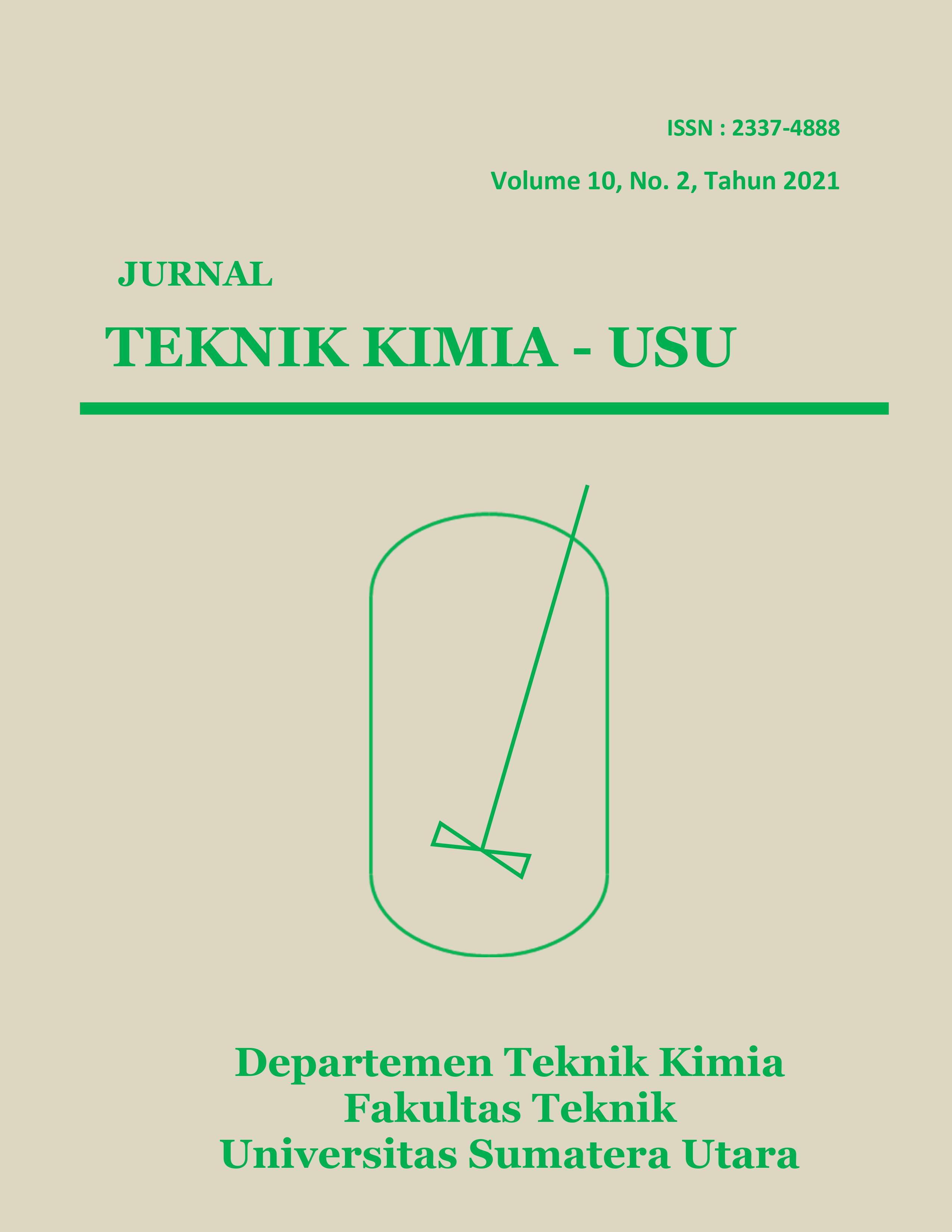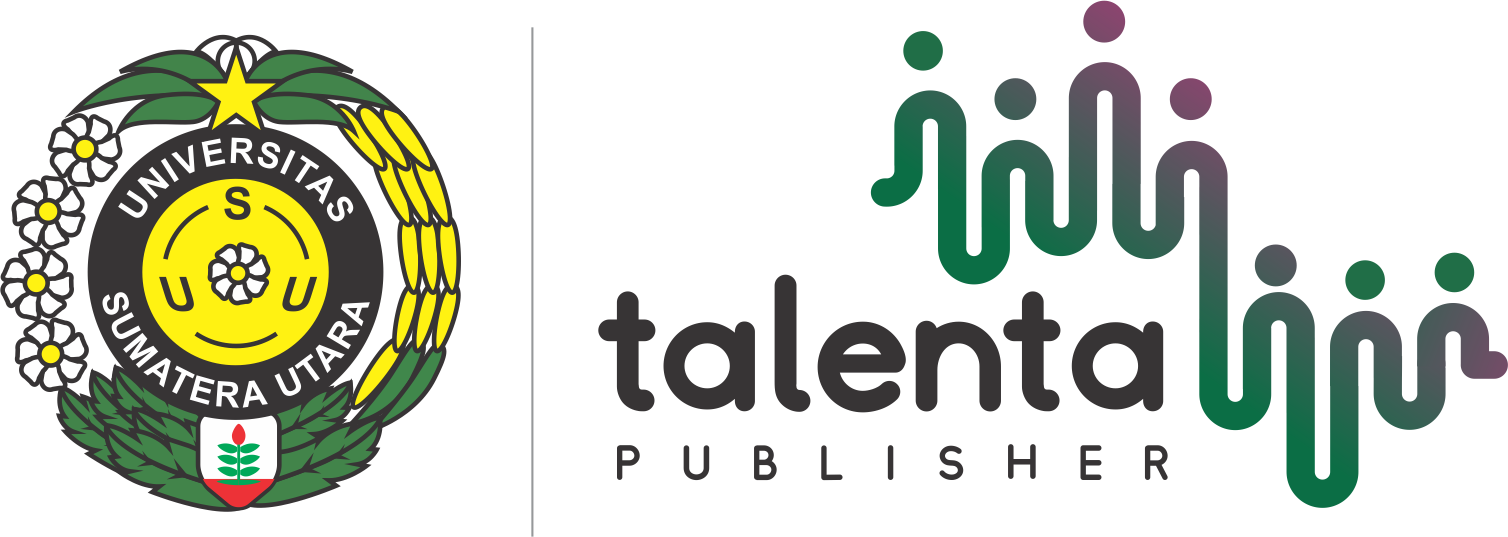Kajian Pembuatan Bioetanol dari Limbah Kulit Nanas (Ananas comosus. L)
DOI:
https://doi.org/10.32734/jtk.v10i2.6603Keywords:
Bioethanol,, fermentation, pineapple peelAbstract
Ethanol is a fuel with a high octane number and is environmentally friendly. Bioethanol which can be made from biomass materials such as pineapple peel, is considered not to interfere with food security. With a fairly high carbohydrate and glucose content, pineapple can be converted into reducing sugars that can be fermented to produce ethanol. This study was conducted using the journal review method and aims to determine the mechanism, the variables that play the role, and the optimum conditions of fermentation in the manufacture of bioethanol from pineapple peel. The focus of the analysis was on hydrolysis, namely the type, concentration of the hydrolyzing agent, pH, temperature, and concentration of yeast in fermentation. The analysis from previous studies, the best hydrolysis was obtained by enzymatic hydrolysis using cellulase enzymes with a concentration of 1%-2%. The optimum pH of fermentation was found at pH 5 to pH 6, the fermentation temperature was 30 oC with a Saccharomyces cerevisiae concentration of 1.5% – 2%, and the optimum fermentation time occurred in the range of 48 to 96 hours. The high amount of reducing sugar produces a high amount of ethanol as well.
Downloads
References
Anonim, (2018, Maret 20). “Kebutuhan listrik disesuaikan, target bauran energi terbarukan tahun 2025 tetap dijaga 23%,†Available: https://www.esdm.go.id/id/media-center/arsip-berita/kebutuhan-listrik-disesuaikan-target-bauran-energi-terbarukan-tahun-2025-tetap-dijaga-23.
M. Rijal, A. Mahulauw, and A. Rumbaru, “Pengaruh konsentrasi Saccharomyces cereviceae terhadap produksi bioetanol berbahan dasar batang jagung,†Biosel Biol. Sci. Educ., vol. 8, no. 1, pp. 59, 2019.
F. Harahap et al., Kultur Jaringan Nanas. Surabaya: Media Sahabat Cendekia, 2019.
Nurhayati, “Penampilan ayam pedaging yang mengkonsumsi pakan mengandung kulit nanas disuplementasi dengan yoghurt,†Agripet, vol. 13, no. 2, pp : 15-20, 2013.
F. G. Winarno, Kimia Pangan Dan Gizi, 11th ed. Jakarta: Gramedia Pustaka Utama, 2004.
R. Hemalatha and S. Anbuselvi, “Physicohemical constituents of pineapple pulp and waste,†J. Chem. Pharm. Res., vol. 5, no. 2, pp. 240–242, 2013.
A. M. Fuadi, K. Harisma, and A. Setiawan, “Pengaruh suhu dan pH terhadap banyaknya yield yang dihasilkan pada proses hidrolisis enzimatis dari limbah kertas,†Simposium Nasional RAPI XIV-2015 FT UMS, 2015, pp. 179–185.
G. P. Arimba, Jasman, Hasanuddin, and Syahrul, “Pemurnian bioetanol limbah kulit nanas menggunakan alat destilasi sederhana model kolom refluks,†J. Zarah, vol. 7, no. 1, pp. 22–28, 2019.
H. Suryanto, “Review serat alam : komposisi, struktur, dan sifat mekanis,†NASPA J., vol. 42, no. 4, pp. 1, 2016.
A. B. Arif, W. Diyono, A. Budiyanto, and N. Richana, “Analisis rancangan faktorial tiga faktor untuk optimalisasi produksi bioetanol dari molases tebu,†Inform. Pertan., vol. 25, no. 1, pp. 145, 2016.
U. G. Akpan, S. Kovo, M. Abdullahi, and J. J. Ijah, “The production of ethanol from maize cobs and groundnut shells,†AU J. Technol., vol. 9, no. 2, pp. 106–110, 2005.
M. Jahid, A. Gupta, and D. K. Sharma, “Production of bioethanol from fruit wastes (banana, papaya, pineapple and mango peels) under milder conditions,†J. Bioprocess. Biotech., vol. 08, no. 03, 2018.
J. T. Casabar, Y. Unpaprom, and R. Ramaraj, “Fermentation of pineapple fruit peel wastes for bioethanol production,†Biomass Convers. Biorefinery, vol. 9, no. 4, pp. 761–765, 2019.
A. Choonut, M. Saejong, and K. Sangkharak, “The production of ethanol and hydrogen from pineapple peel by Saccharomyces cerevisiae and enterobacter aerogenes,†Energy Procedia, vol. 52, pp. 242–249, 2014.
T. Boonwong, S. Karnnasuta, and T. Srinorakutara, “Agricultural wastes potential (pineapple crown, durian peel and sugarcane leaves) on reducing sugar production by using sulfuric acid pretreatment following enzymatic hydrolysis,†KKU Res. J., vol. 19, no. 3, pp. 361–370, 2014.
N. Chatchanun, C. Patiwat, C. Peerapong, and R. Chalerm, “Simple and enhanced production of lignocellulosic ethanol by diluted acid hydrolysis process of pineapple peel (Ananas comosus) waste,†African J. Biotechnol., vol. 13, no. 38, pp. 3928–3934, 2014.
L. Nulhakim, B. Anggo, R. R. Febriana, H. Lukmana, F. Erriana, A. D. Pratwi. dan P. N. Azizah, “Pembuatan bioetanol dari kulit nanas oleh Saccharomyces cerevisiae terimobilisasi dalam butiran alginat,†Seminar Nasional AVoER XI, pp. 1-5, 2019.
M. J. Taherzadeh and K. Karimi, "Pretreatment of lignocellulosic wastes to improve ethanol and biogas production: A review", International Journal of Molecular Sciences, vol. 9, no. 9. 2008.
A. Safwan Alikasturi et al., “Extraction of glucose by using alkaline hydrolysis from Musa sapientum peels, Ananas comosus and Mangifera indica linn,†Mater. Today Proc., vol. 5, no. 10, pp. 22148–22153, 2018,
N. A. S. M. Rosdee, N. Masngut, S. M. Shaarani, S. Jamek, and M. S. M. Sueb, “Enzymatic hydrolysis of lignocellulosic biomass from pineapple leaves by using endo-1,4-xylanase: Effect of pH, temperature, enzyme loading and reaction timeâ€, IOP Conference Series: Materials Science and Engineering, 2020, vol. 736, no. 2.
T. Roukas, “Continuous ethanol production from nonsterilized carob pod extract by immobilized Saccharomyces cerevisiae on mineral kissiris using a two-reactor system,†Appl. Biochem. Biotechnol. - Part A Enzym. Eng. Biotechnol., vol. 59, no. 3, pp. 299–307, 1996.
D. L. Pramita, E. Yenie, and S. R. Muria, “Pembuatan bioetanol dari kulit nenas menggunakan enzim selulose dan yeast Saccharomyces cerevisiae dengan proses Simultaneous Sacharificatian and Fermentation (SSF) terhadap variasi konsentrasi inokulum dan waktu fermentasi,†J. Online Mhs. Fak. Tek. Univ. Riau, pp. 12–49, 2014.
M. Budiarni and T. Gultom, “Pengaruh variasi waktu fermentasi dan berat ragi terhadap kadar alkohol pada pembuatan bioetanol limbah padat tapioka (onggok),†Skripsi, Universitas Negeri Yogyakarta, Yogyakarta, 2013.
J. Pornpunyapat, W. Chotigeat, and P. Chetpattananondh, “Bioethanol production from pineapple peel juice using Saccharomyces cerevisiae,†Adv. Mater. Res., vol. 875–877, pp. 242–245, 2014.
J. Itelima, F. Onwuliri, E. Onwuliri, I. Onyimba, and S. Oforji, “Bio-ethanol production from banana, plantain and pineapple peels by simultaneous saccharification and fermentation process,†Int. J. Environ. Sci. Dev., no. April, pp. 213–216, 2013.
P. R. Babu, M. Mastan, K. Charan, and V. K. Vaishnav, “Optimization of ethanol production from pineapple peel by Saccharomyces cerevisiae,†Int. J. Adv. Sci. Res. Manag., vol. 4, no. 5, 2019.
M. Octria, A. Kiagus, K. A. Roni, and Atikah, “Bioetanol production optimization from pineapple leather fil,†Int. J. Eng. Technol., vol. 7, no. 4, pp. 1–5, 2017.
G. K. K. Kumar and P. V. Senan, “Bioethanol production from local fruit waste and its optimization,†Indian J. Exp. Biol., vol. 58, pp. 879–882, 2020.
M. M. Khandaker, K. B. Qiamuddin, A. Majrashi, T. Dalorima, M. H. Sajili, and A. B. M. Sharif Hossain, “Bio-ethanol production from fruit and vegetable waste by using Saccharomyces cerevisiae,†Biosci. Res., vol. 15, no. 3, pp. 1703–1711, 2018.
R. Hilma, U. Akbar, and Prasetya, “Optimum condition of bioetanol production via acidic hydrolysis from pineaple (Ananas comosus Merr.) peel waste in Kualu Village-Kampar,†1930.
N. Fitria and E. Lindasari, “Optimasi perolehan bioetanol dari kulit nanas (Ananas cosmosus) dengan penambahan urea, variasi konsentrasi inokulasi starter dan waktu fermentasi,†J. Reka Lingkung., vol. 9, no. 1, pp. 1–10, 2020.
G. P. Arimba, Jasman, Hasanuddin, and Syahrul, “Pemurnian bioetanol limbah kulit nanas menggunakan alat distilasi sederhana model kolom refluks,†J. Zarah, vol. 7, no. 1, pp. 22–28, 2019.
A. D. Susanti, P. T. Prakoso, and H. Prabawa, “Pembuatan bioetanol dari kulit nanas melalui hidrolisis dengan asam,†Ekuilibium, vol. 12, no. 1, pp. 11–16, 2013.
T. Kunz, E. J. Lee, V. Schiwek, T. Seewald, and F. J. Methner, “Glucose- a reducing sugar? reducing properties of sugars in beverages and food,†BrewingScience, vol. 64, no. 7–8, pp. 61–67, 2011.
A. Sherif, A. Hussen, and D. Firemichael, “Hydolysis of multi substrate biomass using para-toluenesulphonic acid for bioethanol production: A promising option over the sulfuric acid treatment,†Biomass and Bioenergy, vol. 144, pp. 105922, 2021.
N. I. Febriani, A. Ridlo, and A. Susanto, “Potensi yeast dalam fermentasi alginofit sargassum polycystum C.A Agardh dengan hidrolisis asam sulfat untuk pembuatan bioetanol,†Diponegoro J. Mar. Res., vol. 3, no. 2, pp. 91–98, 2014.
Wignyanto, Suharjono, and Novita, “Pengaruh konsentrasi gula reduksi sari hati nanas dan inokulum Saccharomyces cerevisiae Pada fermentasi etanol,†J. Teknol. Pertan., vol. 2, no. 1, pp. 68–77, 2001.
Downloads
Published
Issue
Section
License
Copyright (c) 2021 Jurnal Teknik Kimia USU

This work is licensed under a Creative Commons Attribution-ShareAlike 4.0 International License.

















